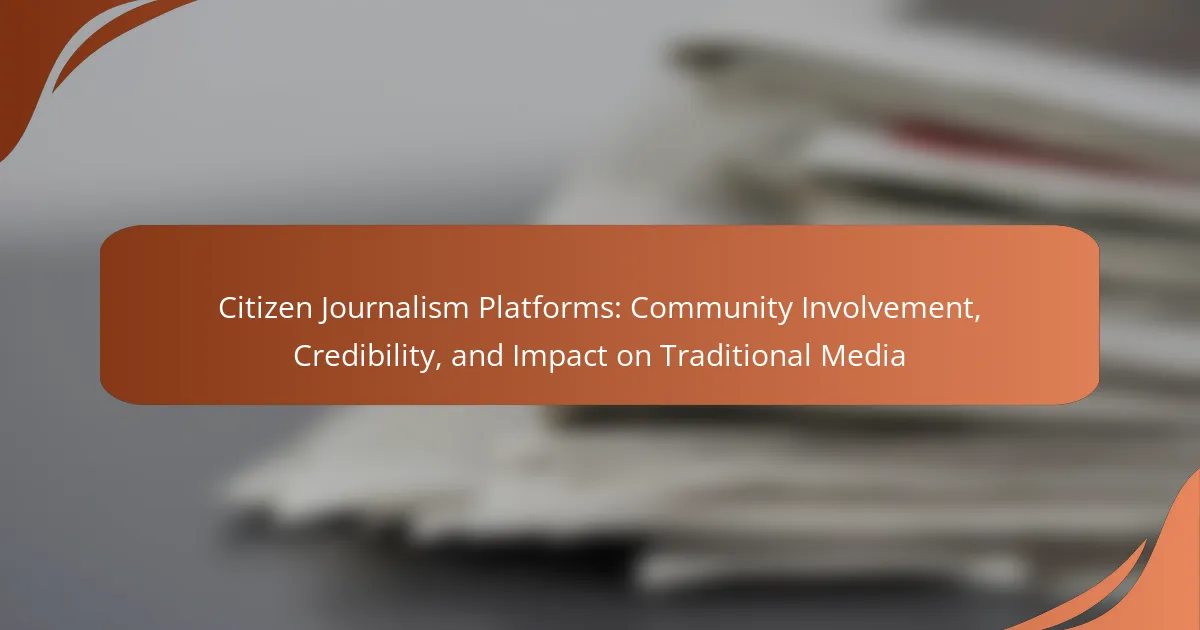Citizen journalism platforms are online spaces that enable individuals to report news and share information, empowering ordinary citizens to act as journalists. These platforms include social media sites, blogs, and dedicated news websites, allowing users to submit articles, videos, and photos that provide diverse perspectives on local events often overlooked by mainstream media. The rise of the internet and mobile technology has contributed to the popularity of citizen journalism, with a significant portion of the population obtaining news from social media. To ensure credibility, these platforms implement verification methods, user-generated content guidelines, and collaboration with established news organizations. The impact of citizen journalism on traditional media is profound, as it democratizes information dissemination, challenges the authority of established outlets, and encourages faster news reporting while raising concerns about accuracy and verification.

What are Citizen Journalism Platforms?
Citizen journalism platforms are online spaces where individuals report news and share information. These platforms empower ordinary citizens to act as journalists. They often include social media sites, blogs, and dedicated news websites. Users can submit articles, videos, and photos. This form of journalism allows for diverse perspectives. It often covers local events that mainstream media might overlook. Citizen journalism has gained popularity due to the rise of the internet and mobile technology. According to a study by the Pew Research Center, 72% of Americans get news from social media. This statistic highlights the significance of citizen journalism platforms in contemporary news dissemination.
How do Citizen Journalism Platforms operate?
Citizen journalism platforms operate by allowing individuals to report news and share information. These platforms provide tools for users to create and publish content. Users can upload articles, photos, and videos from their mobile devices. The content is often shared in real-time, facilitating immediate reporting of events.
Citizen journalism platforms typically have mechanisms for community engagement. Users can comment on, share, and discuss the published content. Some platforms implement moderation to ensure accuracy and credibility. This can involve community voting or editorial oversight.
The operation of these platforms often relies on social media integration. This helps in amplifying the reach of citizen-generated content. Research indicates that citizen journalism can increase public participation in news dissemination. A study by the Pew Research Center found that 72% of Americans get news from social media. This highlights the significant impact of citizen journalism on traditional media consumption.
What technologies support Citizen Journalism Platforms?
Citizen journalism platforms are supported by various technologies that facilitate content creation and distribution. Mobile devices enable citizen journalists to capture and share news in real-time. Social media platforms provide a space for sharing stories and engaging with audiences. Content management systems help organize and publish user-generated content effectively. Geolocation tools enhance the context of stories by providing location data. Live streaming technology allows for immediate broadcasting of events as they unfold. Data analytics tools help assess audience engagement and reach. Collaborative tools enable citizen journalists to work together on stories and share resources. These technologies collectively empower individuals to contribute to news coverage and democratize information sharing.
How do users contribute to these platforms?
Users contribute to citizen journalism platforms by creating and sharing news content. They report local events, provide eyewitness accounts, and upload photos or videos. This grassroots involvement enhances the diversity of stories available. Users also engage in discussions and provide feedback, fostering community dialogue. Their contributions can lead to greater accountability for traditional media. Studies show that user-generated content increases audience trust in the news. For example, platforms like Citizen Journalism have seen a rise in user participation by over 40% in recent years. This active involvement shapes the narratives and issues highlighted in the media landscape.
What role does community involvement play in Citizen Journalism?
Community involvement is crucial in citizen journalism. It enhances the diversity of perspectives and increases the volume of information shared. Engaged communities contribute local knowledge that professional journalists may overlook. This grassroots participation fosters accountability and transparency in reporting. Studies show that citizen-generated content can lead to more accurate and timely news coverage. For instance, during major events, local citizens often provide real-time updates that traditional media may not capture. Furthermore, community involvement builds trust between journalists and the public. This trust is essential for the credibility of the information being disseminated. Overall, community involvement not only enriches the content but also strengthens the democratic process of information sharing.
How does community engagement enhance news coverage?
Community engagement enhances news coverage by fostering deeper connections between journalists and the audience. Engaged communities provide valuable insights and local perspectives. This leads to more relevant and accurate news reporting. For instance, citizen journalists often highlight underreported issues. Their contributions can diversify the narrative landscape. Research shows that audience involvement increases trust in news sources. A study by the Knight Foundation found that engaged communities are more likely to support local journalism. This support can lead to increased funding and resources for news organizations. Overall, community engagement enriches the quality and credibility of news coverage.
What are the benefits of local perspectives in journalism?
Local perspectives in journalism enhance community relevance and engagement. They provide insights into specific issues affecting local populations. Local journalists understand cultural nuances and community dynamics better than outsiders. This leads to more accurate reporting and storytelling. According to a Pew Research Center report, 61% of local news consumers prefer coverage that reflects their community’s interests. This connection fosters trust between journalists and audiences. Local perspectives also empower marginalized voices that may be overlooked in mainstream media. By highlighting these viewpoints, journalism becomes more inclusive and representative.

How do Citizen Journalism Platforms ensure credibility?
Citizen journalism platforms ensure credibility through multiple verification methods. They often implement user-generated content guidelines. These guidelines require contributors to provide sources for their information. Platforms may also employ fact-checkers to review submissions. User ratings and comments can help identify reliable contributors. Transparency about the editorial process enhances trust. Many platforms also collaborate with established news organizations for additional credibility. These practices collectively foster a culture of accountability and reliability.
What are the common challenges to credibility in Citizen Journalism?
Common challenges to credibility in Citizen Journalism include misinformation, lack of verification, and bias. Misinformation can spread rapidly through social media, leading to false narratives. The lack of verification processes means that citizen journalists may not fact-check their sources adequately. This can result in the dissemination of unverified or inaccurate information. Bias is another challenge, as citizen journalists may have personal agendas that influence their reporting. A study by the Pew Research Center highlights that the public often questions the reliability of news from non-professional sources. These challenges can undermine the perceived trustworthiness of citizen journalism.
How can platforms verify the accuracy of user-generated content?
Platforms can verify the accuracy of user-generated content through multiple methods. They can implement fact-checking processes involving trained professionals. These professionals assess the claims made in the content against reliable sources. Platforms can also use algorithms to flag suspicious or misleading information. User ratings and feedback can help identify credible contributors. Cross-referencing with established news outlets strengthens verification efforts. Additionally, platforms can encourage users to provide sources for their claims. Transparency in the verification process builds trust with users. Research indicates that platforms employing these strategies see improved content reliability.
What measures do Citizen Journalism Platforms take to establish trust?
Citizen journalism platforms establish trust through various measures. They often implement verification processes for content submitted by users. This includes fact-checking and cross-referencing information with reliable sources. Many platforms encourage transparency by allowing users to track the origin of the news. They also promote user accountability by requiring real names or verified profiles. Community engagement is fostered through feedback mechanisms, enabling users to report inaccuracies. Additionally, some platforms provide training resources for citizen journalists to enhance reporting skills. Research indicates that platforms with strong community guidelines foster higher user trust levels.
Why is transparency important in Citizen Journalism?
Transparency is important in citizen journalism because it builds trust with the audience. Trust is essential for engaging the community and encouraging participation. When citizen journalists are transparent about their sources and methods, it enhances credibility. Credibility is vital in a landscape filled with misinformation. Studies show that audiences are more likely to believe content that is openly sourced and verified. Transparency also allows for accountability, as it enables the public to scrutinize the information presented. This scrutiny can lead to higher journalistic standards. Ultimately, transparency fosters a more informed society, which is beneficial for democracy.
How does transparency affect audience perception?
Transparency enhances audience perception by fostering trust and credibility. When organizations or platforms are open about their processes and decisions, audiences feel more secure in their information sources. This trust is crucial in citizen journalism, where community involvement is key. Research indicates that transparent communication leads to higher engagement levels. For instance, a study by the Pew Research Center found that 75% of users prefer news sources that provide clear information about their editorial practices. Consequently, transparency not only improves audience perception but also strengthens the relationship between the platform and its community.
What are the best practices for maintaining transparency?
Best practices for maintaining transparency include clear communication of information sources. Platforms should disclose funding sources and potential conflicts of interest. Regular updates on editorial policies enhance credibility. Engaging with the audience fosters trust and accountability. Providing access to original documents supports verification. Training contributors on ethical standards is essential. Transparency reports can quantify engagement and content accuracy. According to a 2021 study by the Pew Research Center, transparency improves audience trust significantly.

What is the impact of Citizen Journalism on traditional media?
Citizen journalism significantly impacts traditional media by altering news production and consumption dynamics. It democratizes information dissemination, allowing ordinary individuals to report news. This shift challenges traditional media’s authority and encourages faster news reporting. Citizen journalists often provide firsthand accounts during crises, enhancing real-time coverage. Studies show that traditional media outlets increasingly rely on citizen-generated content. This collaboration can lead to a more diverse range of perspectives in news coverage. However, it also raises concerns about accuracy and verification. Traditional media must adapt to maintain credibility in this evolving landscape.
How has Citizen Journalism influenced news reporting?
Citizen journalism has significantly influenced news reporting by democratizing the flow of information. It allows ordinary individuals to report news events, often in real-time. This shift has challenged traditional media’s gatekeeping role. As a result, news reporting has become more immediate and diverse. Citizen journalists often provide unique perspectives on events. They can cover stories that mainstream media may overlook. For instance, during the Arab Spring, citizen reports were crucial in documenting protests. Research shows that citizen journalism can enhance accountability in reporting. This influence has led traditional media to adapt by incorporating user-generated content.
What changes have traditional media outlets made in response to Citizen Journalism?
Traditional media outlets have adapted by incorporating user-generated content. They now feature citizen journalism in their reports. This inclusion helps them engage with audiences more effectively. Many outlets have established guidelines for verifying citizen contributions. They also provide platforms for citizen journalists to share their work. Additionally, traditional media has increased collaboration with community members. This approach enhances credibility and trust among viewers. Research indicates that 62% of journalists now use social media for sourcing news. These changes reflect a shift towards a more participatory journalism model.
How do Citizen Journalism Platforms challenge mainstream narratives?
Citizen journalism platforms challenge mainstream narratives by empowering individuals to report news directly. These platforms enable ordinary citizens to share their perspectives and experiences. This often contrasts with traditional media, which may have biases or limitations. Citizen journalists can cover underreported issues, providing alternative viewpoints. For instance, during protests, citizen footage can reveal realities often overlooked by mainstream outlets. Research shows that citizen journalism increases public engagement and awareness. By diversifying sources of information, these platforms foster a more inclusive media landscape. This shift can lead to greater accountability for traditional media.
What are the potential drawbacks of Citizen Journalism?
Citizen journalism can lead to misinformation. Non-professional journalists may lack training in fact-checking. This can result in the spread of unverified information. Additionally, citizen journalists may have biases that influence their reporting. These biases can skew public perception of events. The lack of editorial oversight can further exacerbate these issues. In some cases, citizen journalism may invade privacy or violate ethical standards. This can lead to legal repercussions for individuals involved.
How can misinformation spread through Citizen Journalism Platforms?
Misinformation can spread through Citizen Journalism Platforms due to the lack of editorial oversight. These platforms often allow anyone to publish content without verification. Users may share unverified information quickly, leading to rapid dissemination. The absence of fact-checking increases the risk of false narratives. Social media algorithms can amplify misleading posts, reaching a wider audience. Emotional content tends to be shared more, regardless of accuracy. Additionally, confirmation bias encourages users to share information that aligns with their beliefs. A study by the Massachusetts Institute of Technology found that false news spreads six times faster than true news on social media.
What risks do Citizen Journalists face in their reporting?
Citizen journalists face several risks in their reporting. These include legal repercussions, such as arrest or harassment by authorities. They may encounter physical dangers when covering protests or violent events. Additionally, they can face threats from individuals or groups opposed to their reporting. Misinformation can jeopardize their credibility and safety. Lack of access to resources limits their ability to verify information. They may also struggle with online harassment or cyberbullying. These risks can deter citizen journalists from reporting freely.
What can users do to effectively engage with Citizen Journalism Platforms?
Users can effectively engage with Citizen Journalism Platforms by actively contributing content. They should share local news stories, photos, and videos. Providing accurate information enhances credibility. Engaging in discussions on these platforms fosters community involvement. Users can also follow guidelines to ensure quality submissions. Participating in training or workshops can improve their skills. Sharing content on social media increases visibility and reach. Collaborating with other citizen journalists can enhance the impact of their work.
Citizen journalism platforms are online spaces that empower individuals to report news and share information, often covering local events overlooked by mainstream media. These platforms operate through user-generated content, facilitated by various technologies, and emphasize community involvement to enhance diversity and accountability in reporting. The article examines how citizen journalism influences traditional media, the importance of credibility and transparency in user-generated content, and the challenges that arise, such as misinformation and biases. Additionally, it highlights the role of local perspectives in journalism and the potential risks faced by citizen journalists in their reporting efforts.
